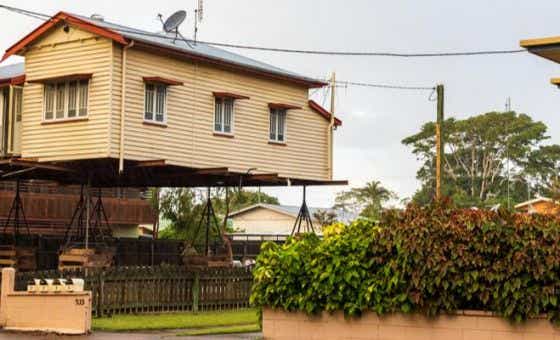How much does restumping a house cost?

If your floors are sloping in one direction or you’ve started to see cracks in your walls, it could be a sign that your house needs restumping. So you don’t feel stumped by the potential cost, we lay out what this process involves and some factors that can impact what you might end up paying.
What is restumping a house?
Restumping, also known as reblocking, is when the existing stumps under a house are replaced with new ones. A house may undergo a full restumping (where all stumps are replaced) or a partial restumping (if some of the stumps are still in good condition). Restumping will commonly involve replacing deteriorated timber stumps – for example, those that have rotted or suffered termite damage – with concrete, galvanised steel or rot-resistant timber stumps.
Restumping can be an important home improvement, because stumps support the structure of the house they sit under. According to building inspection company Housepect, if left untreated, defective stumps can lead to structural damage and potentially result in the house totally or partially collapsing.
What does restumping a house involve?
Generally, the process will begin with a professional assessing which stumps need to be replaced. According to restumping provider Australian Reblocking, this often involves inspecting the stumps for decay, as well using a level to see how even the floor is.
Before starting work, the soil underneath your house should typically also be checked. Global Reblocking says an engineer should assess how deep the stumps should be, depending on the soil condition. This may help to avoid problems in the future.
The next step is jacking up the house and removing the defective stumps. The remaining stump holes may then be reused, or further digging may be required if they aren’t deep enough.
Next, the new stumps will be positioned, ensuring the house will sit level. Once these have all been installed, the house will then be lowered onto the new stumps and secured.
Apply in minutes. No Unloan Fees.
Fee-free extra repayments and redraw.
$0 ANZ set up or ongoing fees
Competitive interest rates
Unlimited repayments and redraw
Fast approval
Canstar may earn a fee for referrals from its website tables, and from Sponsorship or Promotion of certain products. Fees payable by product providers for referrals and Sponsorship or Promotion may vary between providers, website position, and revenue model. Sponsorship or Promotion fees may be higher than referral fees. Sponsored or Promoted products are clearly disclosed as such on website pages. They may appear in a number of areas of the website such as in comparison tables, on hub pages and in articles. Sponsored or Promoted products may be displayed in a fixed position in a table, regardless of the product’s rating, price or other attributes. The table position of a Sponsored or Promoted product does not indicate any ranking or rating by Canstar. For more information please see How We Get Paid.
How much does restumping a house cost?
According to tradie listings website HIREtrades, fully restumping a small to average-sized home with one to three bedrooms could set homeowners back around $10,000 to $25,000, or potentially more depending on the specifics of the job. Trade website HiPages estimates that restumping a house could cost anywhere between $5,000 and $20,000. Building inspection company Action Property Inspections offers an estimate on the higher end of the scale, saying that the cost of restumping a typical home could be between $10,000 to $30,000, depending on the number of stumps that need replacing.
What factors can impact the cost of restumping a house?
In addition to cost fluctuations caused by supply chain issues and other disruption due to the pandemic, the factors that may impact the end cost of a restumping job can include:
- Number of stumps being replaced. Global Reblocking says that in Melbourne, for instance, the average price per stump is between $500 and $700.
- Stump material. Galvanised steel stumps are generally the most expensive option, according to Dion Seminara Architecture. However, these are low maintenance and will typically last for a long time. On the other hand, timber stumps are the cheapest option (cheaper than concrete stumps) but they usually won’t last as long.
- Space underneath your house. The lower your house is to the ground, the more difficult it could be for builders to access the stumps underneath it. According to house stump supplier LevelMaster, in some cases workers may need to excavate or lift the floor boards in order to restump the house, which can add to the costs involved.
- Soil condition. Poor soil conditions can also make the restumping process more expensive.
- Existing foundations. If the existing foundations can be reused, this may cut down on time and costs.
- Existing stump holes. Similarly, if the existing stump holes are reusable, this can also save time and money, as it could mean less digging work is required.
What are the finance options for restumping a house?
Before you dive into the work, thinking about the most suitable way to pay for your renovation to restump your house is an essential step.
Depending on your situation, your options could include:
- paying out of your own pocket – using your savings or a mortgage offset account or redraw facility, if you have one on your home loan
- refinancing your home loan to a larger amount
- starting a line of credit loan
- applying for a new loan – you may be able to use a personal loan or a construction loan, depending on your personal circumstances.
Your credit score can impact the interest rate you are offered on some loan products. You can check your credit score for free with Canstar. It’s always a good idea to ask a lender for a copy of relevant documents, such as a Product Disclosure Statement (PDS) and Target Market Determination (TMD) that may apply, as part of considering your financing options.
How do I know if my house needs restumping?
In addition to visibly rotted or otherwise deteriorated stumps, some common signs that your house may need restumping are:
- doors and windows sticking or not opening and closing properly
- the floor sloping in one direction
- sagging or uneven floors
- cracking interior and exterior walls
- floors that feel spongy or bouncy underfoot
How long does it take to restump a house?
How long restumping takes will depend on a number of factors, including whether you are completely or partially restumping your home. According to Queensland House Restumping, a full home restumping project takes on average seven to nine days, depending on the size of the house. If only a few stumps are being replaced, Queensland House Restumping says it will take approximately one to three days. If existing palings or batons require fitting or if any conduit or taps require re-fitting, this service may also be offered by professionals.
As mentioned above, supply constraints due to the pandemic could mean it will take longer than usual for your builder to source the materials and labour needed for the job.
Original article by Tamika Seeto. Cover image source:Dean Howe Photography/Shutterstock.com.
Thanks for visiting Canstar, Australia’s biggest financial comparison site*
This article was reviewed by our Editor-in-Chief Nina Rinella before it was updated, as part of our fact-checking process.

Alasdair Duncan is a Senior Finance Journalist at Canstar, specialising in home loans, property and lifestyle topics. He has written more than 200 articles for Canstar and his work is widely referenced by other publishers and media outlets, including Yahoo Finance, The New Daily, The Motley Fool and Sky News. He has featured as a guest author for property website homely.com.au.
In his more than 15 years working in the media, Alasdair has written for a broad range of publications. Before joining Canstar, he was a News Editor at Pedestrian.TV, part of Australia’s leading youth media group. His work has also appeared on ABC News, Junkee, Rolling Stone, Kotaku, the Sydney Star Observer and The Brag. He has a Bachelor of Laws (Honours) and a Bachelor of Arts with a major in Journalism from the University of Queensland.
When he is not writing about finance for Canstar, Alasdair can probably be found at the beach with his two dogs or listening to podcasts about pop music. You can follow Alasdair on LinkedIn and Twitter.
Redraw freely – Access your additional payments.
Unlimited additional repayments free of charge.
Try our Home Loans comparison tool to instantly compare Canstar expert rated options.











